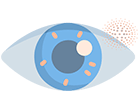Lenaers, G., Hamel, C., Delettre, C., Amati-Bonneau, P., Procaccio, V., Bonneau, D., Reynier, P., & Milea, D. (2012). Dominant optic atrophy. Orphanet journal of rare diseases, 7, 46. https://doi.org/10.1186/1750-1172-7-46
Votruba, M., Moore, A. T., & Bhattacharya, S. S. (1998). Clinical features, molecular genetics, and pathophysiology of dominant optic atrophy. Journal of medical genetics, 35(10), 793–800. https://doi.org/10.1136/jmg.35.10.793
Jones, R., Al-Hayouti, H., Oladiwura, D., Karim, R., Sawczenko, A., & Dahlmann-Noor, A. (2020). Optic atrophy in children: Current causes and diagnostic approach. European journal of ophthalmology, 30(6), 1499–1505. https://doi.org/10.1177/1120672119899378
Chun, B. Y., & Rizzo, J. F., 3rd (2017). Dominant Optic Atrophy and Leber’s Hereditary Optic Neuropathy: Update on Clinical Features and Current Therapeutic Approaches. Seminars in pediatric neurology, 24(2), 129–134. https://doi.org/10.1016/j.spen.2017.06.001
Vaphiades, M. S., & Brodsky, M. C. (2012). Pediatric optic atrophy. International ophthalmology clinics, 52(3), 17–xiii. https://doi.org/10.1097/IIO.0b013e31825a14ba
Pilz, Y. L., Bass, S. J., & Sherman, J. (2017). A Review of Mitochondrial Optic Neuropathies: From Inherited to Acquired Forms. Journal of optometry, 10(4), 205–214. https://doi.org/10.1016/j.optom.2016.09.003





